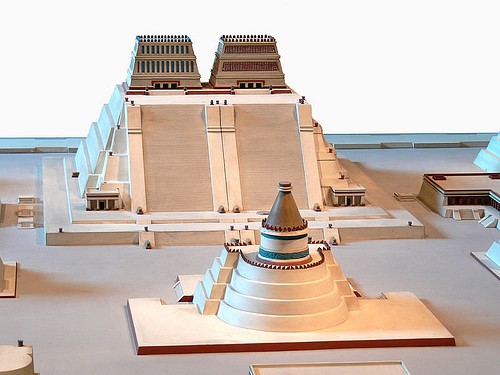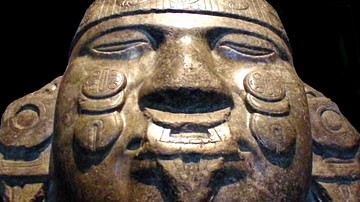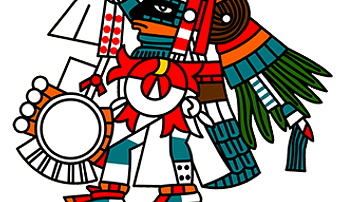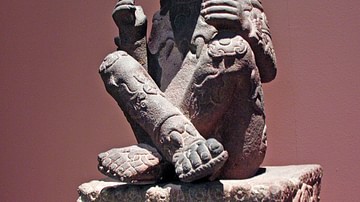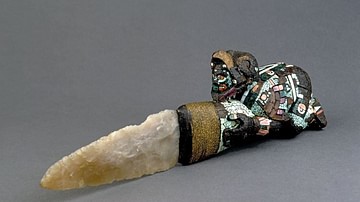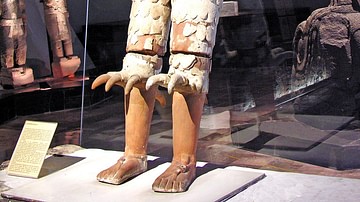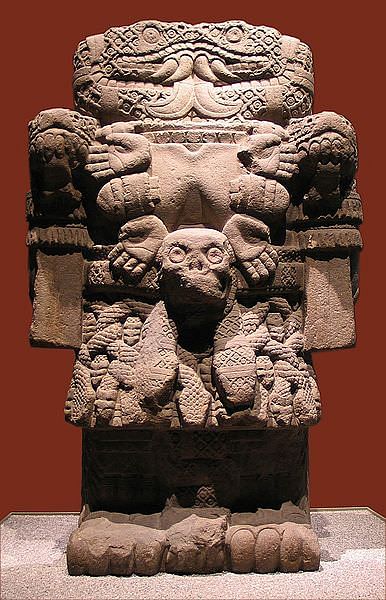
Coatlicue (pron. Co-at-li-cu-e) or 'Serpent Skirt' was a major deity in the Aztec pantheon and regarded as the earth-mother goddess. Coatlicue is represented as an old woman to symbolise the antiquity of earth worship. Coatlicue was the patron of childbirth and was associated with warfare, governance and agriculture. She was considered the female aspect of the primordial god Ometeotl.
Coatlicue presents one of the most fearsome figures in Aztec art. The goddess was worshipped in the spring ritual of Tozozontli in the rainy season and in the autumnal hunting festival of Quecholli, when an impersonator of the goddess was sacrificed.
Coatlicue the Priestess
In Aztec mythology, Coatlicue was actually a priestess whose job was to maintain the shrine on the top of the legendary sacred mountain Coatepec ('Snake Mountain', also spelt Coatepetl). One day, as she was sweeping, a ball of feathers descended from the heavens and when she tucked it into her belt it miraculously impregnated her. The resulting child was none other than the powerful Aztec god of war Huitzilopochtli. However, Coatlicue's other offspring, her daughter Coyolxauhqui ('Painted with Bells' and perhaps representing the Moon), herself a powerful goddess, and her sons the Centzon Huitznahua ('Four Hundred Huiztnaua', who represented the stars of the southern sky) were outraged at this shameful episode and they stormed Mt. Coatepec with the intention of killing their dishonoured mother. The plot came unstuck, though, when one of the Huiztnaua lost heart and decided to warn the still unborn Huitzilopochtli. Rising to his mother's defence the god sprang from the womb fully grown and fully armed as an invincible warrior. In another version, the god springs from his mother's severed neck but either way, with his formidable weapon, the xiuhcoatl ('Fire Serpent') which was actually a ray of the sun, the warrior-god swiftly butchered his unruly siblings and chopping up Coyolxauhqui into several large chunks he lobbed the pieces down the mountainside. The myth may also symbolise the daily victory of the Sun (one of Huitzilpochtli's associations) over the Moon and stars.
The Templo Mayor
This battle would be commemorated with the setting up of the Templo Mayor at the Aztec capital of Tenochtitlan. The giant pyramid was covered in snake sculpture and even the shadows cast by its steps were designed to reference Mt. Coatepec. A further link to the myth was the large stone placed at the base of the pyramid which has a relief carving of the dismembered Coyolxauhqui.
In another myth involving the goddess, Coatlicue warned the Mexica of their future demise. The Aztec ruler Motecuhzoma II had sent a party of 60 magicians to visit Coatlicue in the mythical ancestral home of the Mexica, Aztlan, in a quest for supreme knowledge. However, overburdened with gifts, these hapless magicians got bogged down in a sand hill and the goddess revealed that the Aztec cities would fall one by one. Then, and only then, would her son Huitzilopochtli return to her side.
How is Coatlicue Represented in Art?
In art, Coatlicue is most famously represented in the colossal basalt statue found at Tenochtitlan which now resides in the National Museum of Anthropology in Mexico City. The figure is 3.5 m high, 1.5 m broad and depicts the goddess in her most terrible form with a severed head replaced by two coral snakes, representing flowing blood. She wears a necklace of severed human hands and hearts with a large skull pendant. She also wears her typical skirt of entwined snakes whilst her hands and feet have the large claws which she uses to rip up human corpses before she eats them. This may reference the connection between Coatlicue and the star demons known as the tzitzimime, who the Aztecs believed would devour the human population if the sun should ever fail to rise. At her back, her hair hangs down in 13 tresses symbolic of the 13 months and 13 heavens of Aztec religion. Interestingly, the base of the statue is carved with an earth monster, even though it would never be seen. The statue was discovered in 1790 CE but was thought so terrifying that it was immediately reburied.
